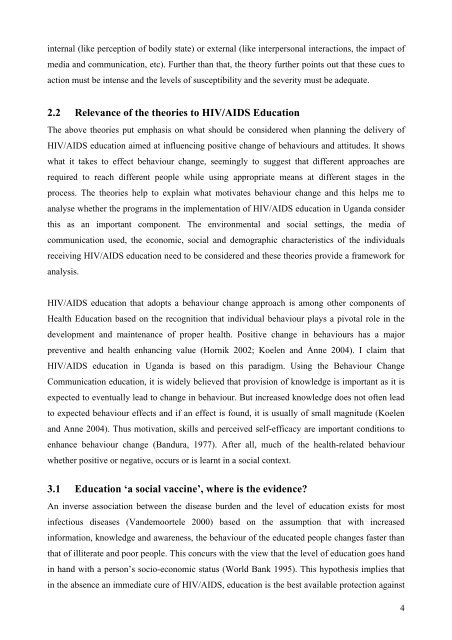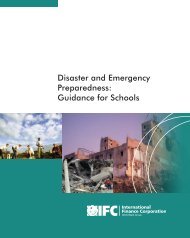Education as "a social vaccine" in the fight against HIV/AIDS - INEE
Education as "a social vaccine" in the fight against HIV/AIDS - INEE
Education as "a social vaccine" in the fight against HIV/AIDS - INEE
- No tags were found...
You also want an ePaper? Increase the reach of your titles
YUMPU automatically turns print PDFs into web optimized ePapers that Google loves.
<strong>in</strong>ternal (like perception of bodily state) or external (like <strong>in</strong>terpersonal <strong>in</strong>teractions, <strong>the</strong> impact ofmedia and communication, etc). Fur<strong>the</strong>r than that, <strong>the</strong> <strong>the</strong>ory fur<strong>the</strong>r po<strong>in</strong>ts out that <strong>the</strong>se cues toaction must be <strong>in</strong>tense and <strong>the</strong> levels of susceptibility and <strong>the</strong> severity must be adequate.2.2 Relevance of <strong>the</strong> <strong>the</strong>ories to <strong>HIV</strong>/<strong>AIDS</strong> <strong>Education</strong>The above <strong>the</strong>ories put emph<strong>as</strong>is on what should be considered when plann<strong>in</strong>g <strong>the</strong> delivery of<strong>HIV</strong>/<strong>AIDS</strong> education aimed at <strong>in</strong>fluenc<strong>in</strong>g positive change of behaviours and attitudes. It showswhat it takes to effect behaviour change, seem<strong>in</strong>gly to suggest that different approaches arerequired to reach different people while us<strong>in</strong>g appropriate means at different stages <strong>in</strong> <strong>the</strong>process. The <strong>the</strong>ories help to expla<strong>in</strong> what motivates behaviour change and this helps me toanalyse whe<strong>the</strong>r <strong>the</strong> programs <strong>in</strong> <strong>the</strong> implementation of <strong>HIV</strong>/<strong>AIDS</strong> education <strong>in</strong> Uganda considerthis <strong>as</strong> an important component. The environmental and <strong>social</strong> sett<strong>in</strong>gs, <strong>the</strong> media ofcommunication used, <strong>the</strong> economic, <strong>social</strong> and demographic characteristics of <strong>the</strong> <strong>in</strong>dividualsreceiv<strong>in</strong>g <strong>HIV</strong>/<strong>AIDS</strong> education need to be considered and <strong>the</strong>se <strong>the</strong>ories provide a framework foranalysis.<strong>HIV</strong>/<strong>AIDS</strong> education that adopts a behaviour change approach is among o<strong>the</strong>r components ofHealth <strong>Education</strong> b<strong>as</strong>ed on <strong>the</strong> recognition that <strong>in</strong>dividual behaviour plays a pivotal role <strong>in</strong> <strong>the</strong>development and ma<strong>in</strong>tenance of proper health. Positive change <strong>in</strong> behaviours h<strong>as</strong> a majorpreventive and health enhanc<strong>in</strong>g value (Hornik 2002; Koelen and Anne 2004). I claim that<strong>HIV</strong>/<strong>AIDS</strong> education <strong>in</strong> Uganda is b<strong>as</strong>ed on this paradigm. Us<strong>in</strong>g <strong>the</strong> Behaviour ChangeCommunication education, it is widely believed that provision of knowledge is important <strong>as</strong> it isexpected to eventually lead to change <strong>in</strong> behaviour. But <strong>in</strong>cre<strong>as</strong>ed knowledge does not often leadto expected behaviour effects and if an effect is found, it is usually of small magnitude (Koelenand Anne 2004). Thus motivation, skills and perceived self-efficacy are important conditions toenhance behaviour change (Bandura, 1977). After all, much of <strong>the</strong> health-related behaviourwhe<strong>the</strong>r positive or negative, occurs or is learnt <strong>in</strong> a <strong>social</strong> context.3.1 <strong>Education</strong> ‘a <strong>social</strong> vacc<strong>in</strong>e’, where is <strong>the</strong> evidence?An <strong>in</strong>verse <strong>as</strong>sociation between <strong>the</strong> dise<strong>as</strong>e burden and <strong>the</strong> level of education exists for most<strong>in</strong>fectious dise<strong>as</strong>es (Vandemoortele 2000) b<strong>as</strong>ed on <strong>the</strong> <strong>as</strong>sumption that with <strong>in</strong>cre<strong>as</strong>ed<strong>in</strong>formation, knowledge and awareness, <strong>the</strong> behaviour of <strong>the</strong> educated people changes f<strong>as</strong>ter thanthat of illiterate and poor people. This concurs with <strong>the</strong> view that <strong>the</strong> level of education goes hand<strong>in</strong> hand with a person’s socio-economic status (World Bank 1995). This hypo<strong>the</strong>sis implies that<strong>in</strong> <strong>the</strong> absence an immediate cure of <strong>HIV</strong>/<strong>AIDS</strong>, education is <strong>the</strong> best available protection aga<strong>in</strong>st4
















